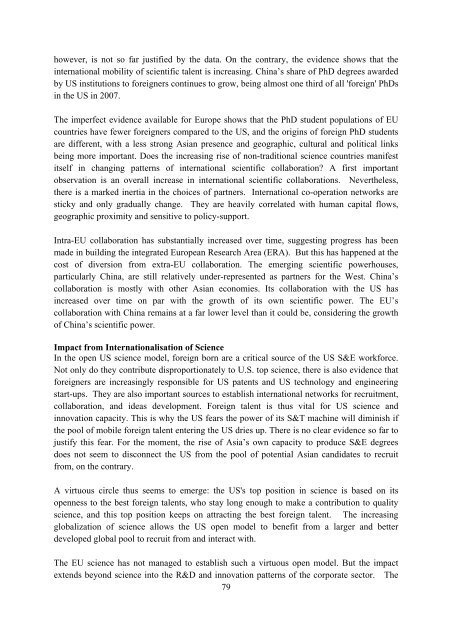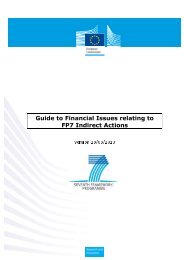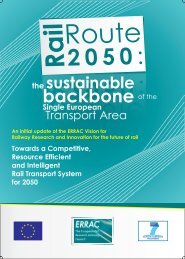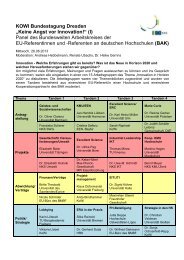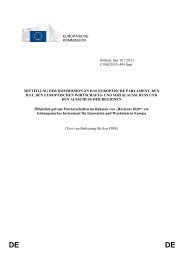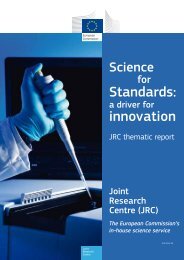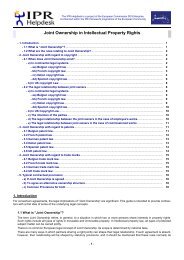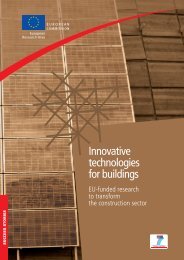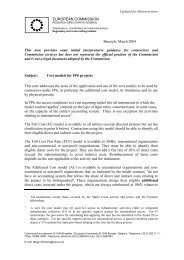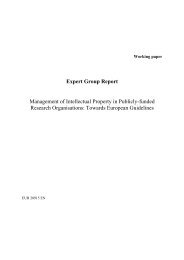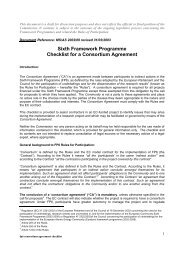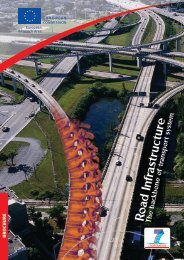Draft Report of the Expert Group on International STI Cooperation to ...
Draft Report of the Expert Group on International STI Cooperation to ...
Draft Report of the Expert Group on International STI Cooperation to ...
Create successful ePaper yourself
Turn your PDF publications into a flip-book with our unique Google optimized e-Paper software.
however, is not so far justified by <str<strong>on</strong>g>the</str<strong>on</strong>g> data. On <str<strong>on</strong>g>the</str<strong>on</strong>g> c<strong>on</strong>trary, <str<strong>on</strong>g>the</str<strong>on</strong>g> evidence shows that <str<strong>on</strong>g>the</str<strong>on</strong>g><br />
internati<strong>on</strong>al mobility <str<strong>on</strong>g>of</str<strong>on</strong>g> scientific talent is increasing. China’s share <str<strong>on</strong>g>of</str<strong>on</strong>g> PhD degrees awarded<br />
by US instituti<strong>on</strong>s <strong>to</strong> foreigners c<strong>on</strong>tinues <strong>to</strong> grow, being almost <strong>on</strong>e third <str<strong>on</strong>g>of</str<strong>on</strong>g> all 'foreign' PhDs<br />
in <str<strong>on</strong>g>the</str<strong>on</strong>g> US in 2007.<br />
The imperfect evidence available for Europe shows that <str<strong>on</strong>g>the</str<strong>on</strong>g> PhD student populati<strong>on</strong>s <str<strong>on</strong>g>of</str<strong>on</strong>g> EU<br />
countries have fewer foreigners compared <strong>to</strong> <str<strong>on</strong>g>the</str<strong>on</strong>g> US, and <str<strong>on</strong>g>the</str<strong>on</strong>g> origins <str<strong>on</strong>g>of</str<strong>on</strong>g> foreign PhD students<br />
are different, with a less str<strong>on</strong>g Asian presence and geographic, cultural and political links<br />
being more important. Does <str<strong>on</strong>g>the</str<strong>on</strong>g> increasing rise <str<strong>on</strong>g>of</str<strong>on</strong>g> n<strong>on</strong>-traditi<strong>on</strong>al science countries manifest<br />
itself in changing patterns <str<strong>on</strong>g>of</str<strong>on</strong>g> internati<strong>on</strong>al scientific collaborati<strong>on</strong>? A first important<br />
observati<strong>on</strong> is an overall increase in internati<strong>on</strong>al scientific collaborati<strong>on</strong>s. Never<str<strong>on</strong>g>the</str<strong>on</strong>g>less,<br />
<str<strong>on</strong>g>the</str<strong>on</strong>g>re is a marked inertia in <str<strong>on</strong>g>the</str<strong>on</strong>g> choices <str<strong>on</strong>g>of</str<strong>on</strong>g> partners. Internati<strong>on</strong>al co-operati<strong>on</strong> networks are<br />
sticky and <strong>on</strong>ly gradually change. They are heavily correlated with human capital flows,<br />
geographic proximity and sensitive <strong>to</strong> policy-support.<br />
Intra-EU collaborati<strong>on</strong> has substantially increased over time, suggesting progress has been<br />
made in building <str<strong>on</strong>g>the</str<strong>on</strong>g> integrated European Research Area (ERA). But this has happened at <str<strong>on</strong>g>the</str<strong>on</strong>g><br />
cost <str<strong>on</strong>g>of</str<strong>on</strong>g> diversi<strong>on</strong> from extra-EU collaborati<strong>on</strong>. The emerging scientific powerhouses,<br />
particularly China, are still relatively under-represented as partners for <str<strong>on</strong>g>the</str<strong>on</strong>g> West. China’s<br />
collaborati<strong>on</strong> is mostly with o<str<strong>on</strong>g>the</str<strong>on</strong>g>r Asian ec<strong>on</strong>omies. Its collaborati<strong>on</strong> with <str<strong>on</strong>g>the</str<strong>on</strong>g> US has<br />
increased over time <strong>on</strong> par with <str<strong>on</strong>g>the</str<strong>on</strong>g> growth <str<strong>on</strong>g>of</str<strong>on</strong>g> its own scientific power. The EU’s<br />
collaborati<strong>on</strong> with China remains at a far lower level than it could be, c<strong>on</strong>sidering <str<strong>on</strong>g>the</str<strong>on</strong>g> growth<br />
<str<strong>on</strong>g>of</str<strong>on</strong>g> China’s scientific power.<br />
Impact from Internati<strong>on</strong>alisati<strong>on</strong> <str<strong>on</strong>g>of</str<strong>on</strong>g> Science<br />
In <str<strong>on</strong>g>the</str<strong>on</strong>g> open US science model, foreign born are a critical source <str<strong>on</strong>g>of</str<strong>on</strong>g> <str<strong>on</strong>g>the</str<strong>on</strong>g> US S&E workforce.<br />
Not <strong>on</strong>ly do <str<strong>on</strong>g>the</str<strong>on</strong>g>y c<strong>on</strong>tribute disproporti<strong>on</strong>ately <strong>to</strong> U.S. <strong>to</strong>p science, <str<strong>on</strong>g>the</str<strong>on</strong>g>re is also evidence that<br />
foreigners are increasingly resp<strong>on</strong>sible for US patents and US technology and engineering<br />
start-ups. They are also important sources <strong>to</strong> establish internati<strong>on</strong>al networks for recruitment,<br />
collaborati<strong>on</strong>, and ideas development. Foreign talent is thus vital for US science and<br />
innovati<strong>on</strong> capacity. This is why <str<strong>on</strong>g>the</str<strong>on</strong>g> US fears <str<strong>on</strong>g>the</str<strong>on</strong>g> power <str<strong>on</strong>g>of</str<strong>on</strong>g> its S&T machine will diminish if<br />
<str<strong>on</strong>g>the</str<strong>on</strong>g> pool <str<strong>on</strong>g>of</str<strong>on</strong>g> mobile foreign talent entering <str<strong>on</strong>g>the</str<strong>on</strong>g> US dries up. There is no clear evidence so far <strong>to</strong><br />
justify this fear. For <str<strong>on</strong>g>the</str<strong>on</strong>g> moment, <str<strong>on</strong>g>the</str<strong>on</strong>g> rise <str<strong>on</strong>g>of</str<strong>on</strong>g> Asia’s own capacity <strong>to</strong> produce S&E degrees<br />
does not seem <strong>to</strong> disc<strong>on</strong>nect <str<strong>on</strong>g>the</str<strong>on</strong>g> US from <str<strong>on</strong>g>the</str<strong>on</strong>g> pool <str<strong>on</strong>g>of</str<strong>on</strong>g> potential Asian candidates <strong>to</strong> recruit<br />
from, <strong>on</strong> <str<strong>on</strong>g>the</str<strong>on</strong>g> c<strong>on</strong>trary.<br />
A virtuous circle thus seems <strong>to</strong> emerge: <str<strong>on</strong>g>the</str<strong>on</strong>g> US's <strong>to</strong>p positi<strong>on</strong> in science is based <strong>on</strong> its<br />
openness <strong>to</strong> <str<strong>on</strong>g>the</str<strong>on</strong>g> best foreign talents, who stay l<strong>on</strong>g enough <strong>to</strong> make a c<strong>on</strong>tributi<strong>on</strong> <strong>to</strong> quality<br />
science, and this <strong>to</strong>p positi<strong>on</strong> keeps <strong>on</strong> attracting <str<strong>on</strong>g>the</str<strong>on</strong>g> best foreign talent. The increasing<br />
globalizati<strong>on</strong> <str<strong>on</strong>g>of</str<strong>on</strong>g> science allows <str<strong>on</strong>g>the</str<strong>on</strong>g> US open model <strong>to</strong> benefit from a larger and better<br />
developed global pool <strong>to</strong> recruit from and interact with.<br />
The EU science has not managed <strong>to</strong> establish such a virtuous open model. But <str<strong>on</strong>g>the</str<strong>on</strong>g> impact<br />
extends bey<strong>on</strong>d science in<strong>to</strong> <str<strong>on</strong>g>the</str<strong>on</strong>g> R&D and innovati<strong>on</strong> patterns <str<strong>on</strong>g>of</str<strong>on</strong>g> <str<strong>on</strong>g>the</str<strong>on</strong>g> corporate sec<strong>to</strong>r. The<br />
79


